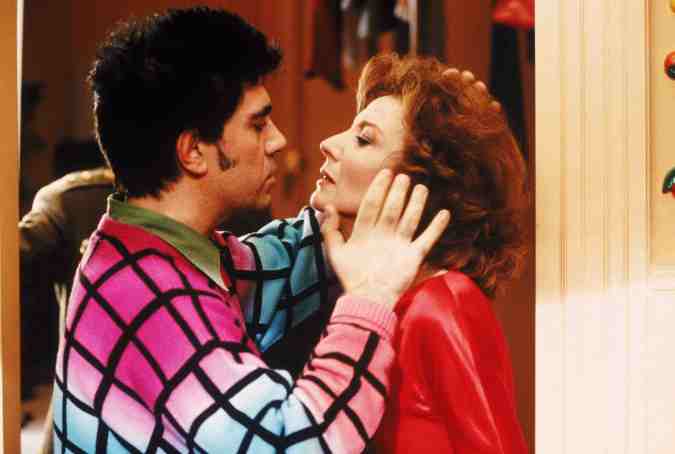As pop culture has taught us well, there’s an undeniable artistic synergy between music and movies. It’s impossible to imagine Quentin Tarantino’s pulp grit, Wes Anderson’s vintage quirkiness or the epic fantasy of the Star Wars films without the soundtracks and scores that accompany each decadent visual spectacle. Just last year, Alfonso Cuarón’s award season masterpiece, Roma, became a prime example of the ways music, or lack thereof, can enhance celluloid storytelling – packed with subtle environmental sounds and profoundly sentimental song choices that made the film a vivid recreation of the director’s childhood upbringing in Mexico City.
This year, Pedro Almodóvar, another master of the audiovisual one-two punch, has made a grand return with Dolor y Gloria (Pain and Glory), a movie that, like Roma, is heavily inspired by the director’s own personal life. Unspooling the minutiae of his health and creative struggles, Dolor y Gloria draws us back into Almodóvar’s unique world of inter-personal intrigue, bold, colorful cinematography and narrative melodrama. The musical cues are also in familiar territory, with longtime collaborator Alberto Iglesias returning to score the film and even featuring a beautiful, raw rendition of Lola Flores’ “A tu Vera,” led by Penelope Cruz and Spanish pop sensation Rosalía.

Music has remained a constant within Almodóvar’s four-decade career – a tool first harnessed during his days at the front of la movida madrileña. Early movies like Pepi, Luci, Bom y otras chicas del montón (Pepi, Luci, Bom and Other Average Girls) feature raucous performances by Alaska y Los Pegamoides, while in 1982’s Laberinto de pasiones (Labyrinth of Passion), Almodóvar himself took the stage alongside Spanish new wave fixture McNamara to perform a kitschy original called “Suck It To Me.” And yet, while later films frequently pay homage to flamenco icons and other cult Spanish figures, it’s Latin American artists who have provided the most enduring musical snapshots within his oeuvre.
Almodóvar’s longtime musical muse is without question Chavela Vargas, the Costa Rican-Mexican powerhouse that transformed Mexican rancheras by turning the genre’s boisterous machismo on its head. The profound sadness and gender subversiveness of her work is extremely compatible with Almodóvar’s campy narratives, which often follow stories of women, queers and trans people who must overcome dire, demeaning circumstances.

Chavela Vargas was a close personal friend of Almodóvar, and the director has featured her songs in five of his movies, including 1993’s Kika, 1997’s Carne trémula and now Dolor y Gloria. Her gutting cover of Dolores Durán’s “La Noche De Mi Amor” prefaces a long-anticipated reconnection between Antonio Bandera’s Salvador Mallo – a loving portrayal of the director – and a great romance from his past. “She absolved you of all of your sins,” Almodóvar said in a 2017 documentary about the singer, “then she encouraged you to commit them again.”

Vargas is also featured in 1995’s La flor de mi secreto (The Flower of My Secret), a film that follows Marisa Paredes’s Leo Macías as she balances a precarious literary double life and a crumbling marriage. Almodóvar uses Vargas’ cheeky “En El Último Trago” to humorously underscore an all-time low for the character, who is nursing the worst hangover of her life after attempting suicide the night before. However, the film’s beating musical heart is Bola de Nieve’s classic “Ay Amor,” which gives name to Leo’s unpublished novel, Dolor y Vida – a central plot device – and acts as an allegory for the story’s overarching themes of melancholy and denial. “Si solo queda en mí, dolor y vida / ay amor, no me dejes vivir,” sings the Afro-Cuban jazz legend in a scene following Leo’s physical and psychological collapse – secrets rapidly unraveling and death looking ever more enticing.
Almodóvar also relishes a strong sense of melodrama, an emotion readily available across the Latin American songbook. 1988’s Mujeres al borde de un ataque de nervios (Women on the Verge of a Nervous Breakdown) is both one of his most beloved films and perhaps his finest collision of musical and onscreen dramatics. The film is bookended by Lola Beltrán’s boozy “Soy Infeliz” and La Lupe’s searing “Puro Teatro,” casting the divas as disembodied confidants of the titular women beleaguered by lying, cheating, ‘ain’t sh*t’ men.

Midway through the movie, Carmen Maura’s Pepa comes into her living room only to find “Soy Infeliz” playing on her record player once more. Fed up with her own self-pity, she tosses the record out the window, hitting her former lover’s new mistress over the head and further cementing Beltrán’s gal pal allegiance to the cast of maligned characters.
While often kooky, Almodóvar’s intent is far from fetishistic. The use of Lucho Gatica’s “Encadenados” in Entre tinieblas (Dark Habits), Los Hermanos Rosario’s “Pecadora” in Tacones lejanos (Hight Heels) or even Bernardo Bonezzi’s hilarious Taxi Mambo theme in Mujeres al borde might all be used for euphoric or comedic effect, but never at the expense of the artists or the worlds that bred them. Veneration and reciprocity are also important, with Almodóvar frequently favoring Latin American renditions of European classics and vice versa. Fine examples include Brazilian chanteuse Maysa Matarazzo’s take on Jacques Brel’s “Ne me quitte pas” in La ley del deseo (Law of Desire) and Spanish pop icon Luz Casal’s hypnotic version of Agustín Lara’s “Piensa En Mí” in Tacones lejanos.
Above all, Almodóvar is a storyteller. And while often conjuring the voices of other storytellers to fuel his complex set pieces, his main concern has always been conveying the depths of human emotion – a raw and strange world of possibility. Singing, laughing or crying are just an added bonus.




